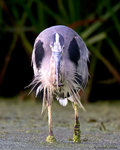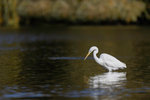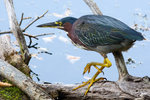




For birds, like for humans, vision is the most important of the senses. They rely on it for all their vital life tasks, from finding food to avoiding being food for others. Most bird photographs are taken from the side and show that the eyes of most birds are located on the side of the head, the owls being a noted exception. This suggests that their eyes function separately, and some do.
However, for most birds, their heads and bills are narrow, so their eyes are able to see forward. I had a difficult time locating photographs to illustrate this. Fortunately found the accompanying photo by Mary Hollard. You can find more about her work at her blog, https://naturallycuriouswithmaryholland.wordpress.com.
Two eyes working together create binocular vision -- the merging of two visual messages into one three-dimensional image. This makes the task of finding food much more successful.
Herons and egrets, however, have a greater problem to overcome, and that is the challenge of light refraction. When passing through the air, light travels in a straight line. Thus, when a heron sees the light reflecting from a snake in the grass, that snake is actually where it appears to be. But when light passes through water and then to your eye, it bends; that phenomenon is called refraction.
You can experience light refraction yourself by simply filling a plain glass with water and inserting a straw or other straight item, as illustrated. The straw appears to change direction – to be located somewhere where it is not. Move the straw, or your observation point, to other locations and note how the illusion also changes.
Imagine you are a hungry Great Egret, and an appealing fish is swimming nearby. Because of refraction, the light bouncing off that fish bends at the water’s surface. The fish is not actually where it appears to be, and if you strike at its apparent location, you will miss your dinner.Studies conducted in controlled conditions using Great Egrets determined that these birds are able to correct for the illusion. They change their location slightly, viewing their prey from different angles, and eventually, they strike quickly, usually catching the fish in their open bills. Somehow inside these birds’ brains they are able to do the complex calculations necessary to adjust for refraction. Researchers know what they do but don’t know how they do it. Even for experts, it’s hard to study a bird’s brain.
Herons and egrets also deal with the refraction problem by using cleaver fishing techniques – methods to trick fish into coming to the surface where they can be more easily caught. Some egrets have been observed lightly patting the water’s surface with their bill, imitating a struggling insect to attract fish. Another species, the Green Heron, has been observed plucking tiny feathers and placing them on the surface, their version of fly fishing. Green Herons are sometimes seen in Thurston County, but they are quite stealthy and difficult to spot.
There are many other fish-eating birds, but none seem to deal with refraction like the herons. Some fish-catching birds, for example Belted Kingfisher, gulls and terns, take another approach. They hover above their prey, keeping their head still while adjusting their wings and body. When the moment is just right, with the prey near the water’s surface, they quickly strike to capture the fish.
Others, like mergansers, cormorants and loons, dive underwater to pursue their fish prey. Refraction isn’t a problem for them, but blurry vision is. They have tiny muscles that squeeze the lenses of their eyes, creating a curved surface that helps focus the images their eyes receive underwater.
Some of the larger fish predators like Osprey and Brown Pelican simply crash into the water where they see fish, ignoring the refraction problem. The Osprey’s wide feet and sharp talons grip tightly on whatever they hit. Pelicans seek out schools of small fish, capturing them (and a lot of water – up to three gallons) in their wide balloon-like pouches.
For creatures with such small heads, birds are remarkably and mysteriously brainy.
George Walter is environmental program manager at the Nisqually Indian Tribe’s natural resources department; he also has a 40+ year interest in bird watching. He may be reached at george@theJOLTnews.com
Photos for this column, unless otherwise noted, are provided by Liam Hutcheson, a 15-year-old Olympia area birder and avid photographer.
Comments
No comments on this item Please log in to comment by clicking here